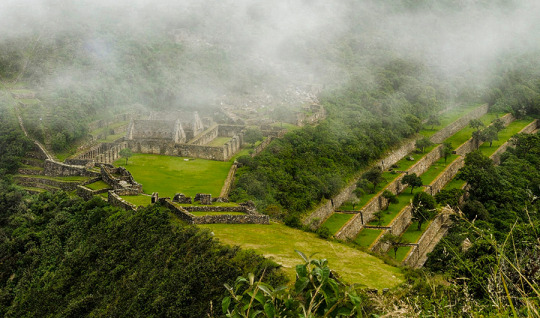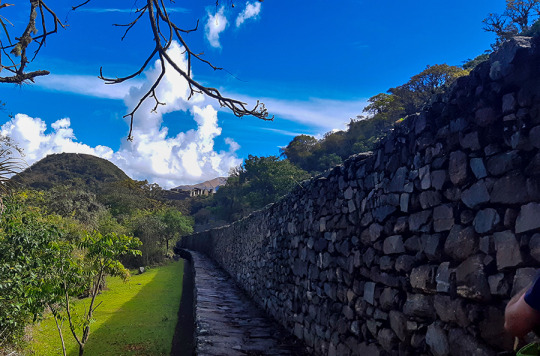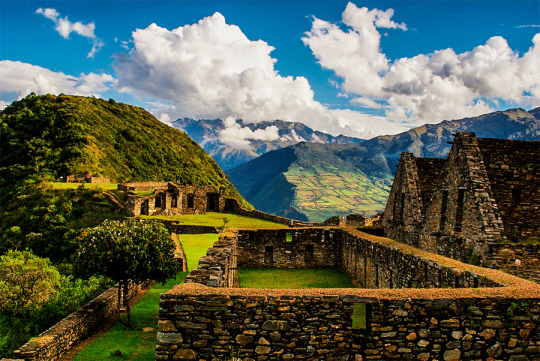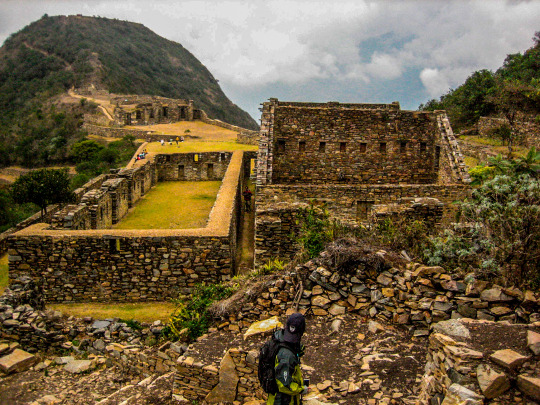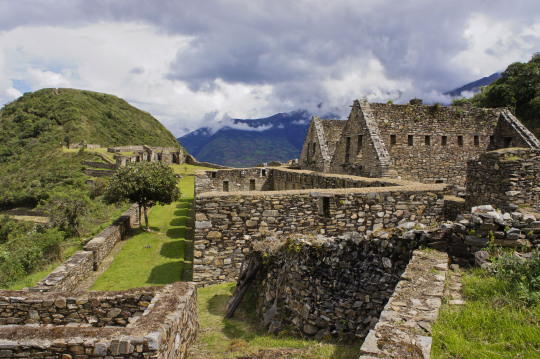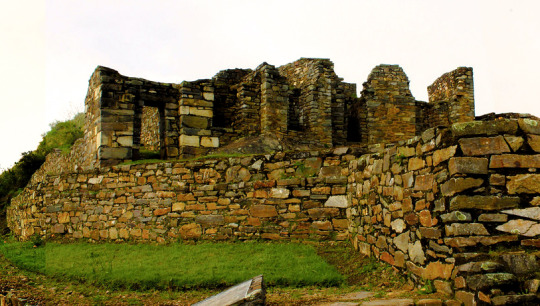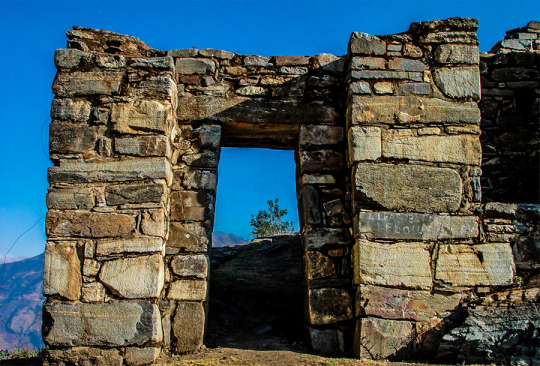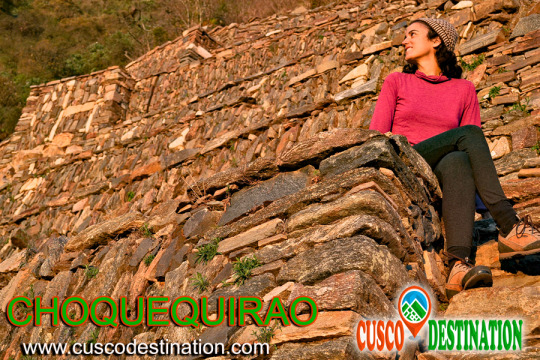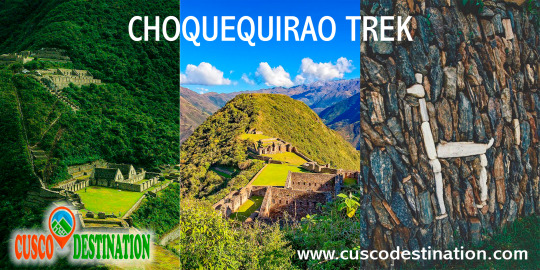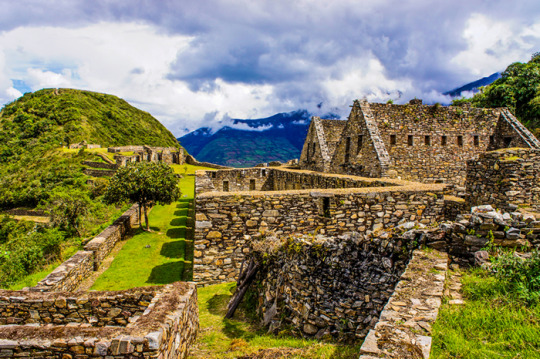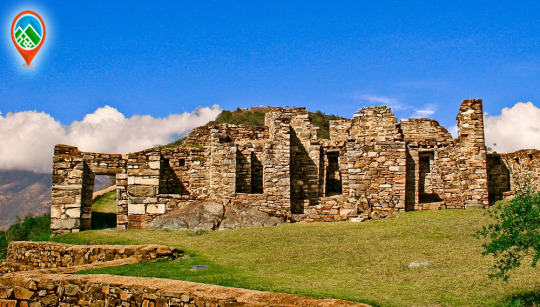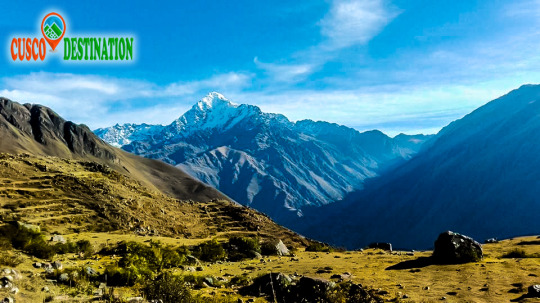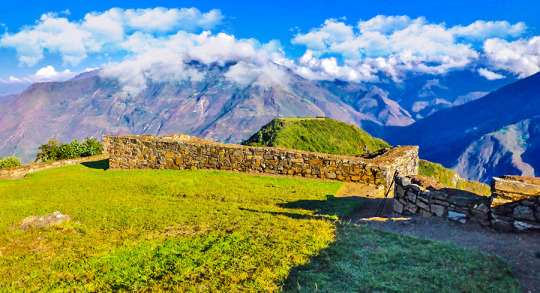Choquequirao is a Quechua word that means 'Cradle of Gold'. The name comes from the nomination of a hill near the archaeological site.
Where it is located?
Choquequirao is located in one of the fringes of the snowy Salkantay, north of the Apurímac River. It is currently located in the Santa Teresa district, La Convencion province, Cusco department, Peru.
How high is it?
Choquequirao is located 3,033 meters above sea level (m.s.n.m.). Due to its location, it is presumed that this Inca site served as a checkpoint between the main Inca sites such as Pisac, Cusco and Machu Picchu.
What's in Choquequirao?
Choquequirao has only been excavated by 30%. Despite this, it already has several very important Inca buildings:
Main square - The main square or Huaqaypata divided the enclosure into two. It is a two-story stone construction. Along with this, there are other buildings connected to each other.
Colcas - Typical constructions of the main Inca centers. In Choquequirao, these platforms have internal subdivisions. The purpose of these warehouses was to store products for food, clothing and others.
Platforms - Choquequirao has a significant number of platforms for cultivation. In the western sector there are 22 engravings in the form of a flame arranged on 15 platforms. These figures are known as the 'Flames of the Sun'.
Housing - In the highest part of Choquequirao, there are up to 5 buildings whose purpose was probably housing for the priests of the compound. This Inca site is believed to have been an important ceremonial center.
Inca Cemetery - Also known as the 'Triumphal Wall'. There were found 17 funeral bundles and a water trough called "The House of the Fall of Water".
Kallankas - These rectangular buildings had multiple functions such as workshop, administrative center, meeting space, etc. In Choquequirao there are 2 Kallankas on whose walls there were gutters that supplied water.
Ushnu - This oval platform construction sits on top of a hill. Due to the wall that surrounds it and the privileged view of the snow-capped mountains, the river and the entire enclosure; it is believed to have had a religious purpose.
CHOQUEQUIRAO TREK TO MACHU PICCHU 7 DAYS

Day 1: CUSCO - CACHORA - COCAMASANA - PLAYA ROSALINA.
We will pick you up at your hotel in a private bus. We start from Cusco, then we go to the town of Cachora (3100 masl), here we find the carriers and support staff, in Cachora we’ll start our walk, after 2 hours of walking we reach Capuliyoc (2915 m) from there we’ll have a beautiful view of the snowy peaks Padrayoc, Wayna Cachora and the Apurimac valley. Then we’ll descend toward Coca Masana (2330m) where the climate becomes warmer and the flora and fauna begin to change. Finally we reach the Rosalina beach (1550m) located on the bank of the Apurimac River where we will have dinner and spend the night.
- Meals: Lunch, Dinner
- Acomodación: Camp, Playa Rosalina 1550 msnm
- Climate : warm and sunny
- Distance Travelled: Approximately 12km
- Hiking time : 6 hour
Day 2: PLAYA ROSALINA – CHOQUEQUIRAO.
This day is the hardest of the five days, we will get up very early. After breakfast, we begin our trek by a steep road for about 5 hours until we reach Raqaypata where we will have lunch. Throughout the walk we will observe many orchids and wild flowers, many birds. From Raqaypata we’ll walk for about two hours to the archaeological site of Choquequirao and there we will observe the sunset and the flight of the condor. Our campsite will be installed outside the ruins.
- Meals: Breakfast, Lunch, Dinner
- Acomodación: Camp, Choquekiraw 3100 msnm
- Climate : warm and cold at night
- Distance Travelled: Approximately 14km
- Hiking time : 7 hour
Day 3: CHOQUEQUIRAO - PINCHINUYOC
After breakfast. We dedicate this mornig to explore the ruins of Choquequirao, and have a little rest before lunch. In the afternoon we begin our trek by a steep road for about 2 hours until we reach Pinchinuyoc where we will camp for the night. This is definitely the easiest day of the trip
- Meals: Breakfast, Lunch, Dinner
- Acomodación: Camp, Pinchinuyoc 2100msnm.
- Climate : warm, windy and cold at night
- Distance Travelled: Approximately 12km
- Hiking time : 8 hour
Day 4: PINCHINUYOC – RIO BLANCO - MAIZAL.
After breakfast, we will hike down hill for 2 hours and arrive at the canyon of the Rio Blanco (1990 m / 6527 feet), where you can dip your feet in the cool waters. where we have a rest before starting a difficult climb to our campsite of Maizal (2100 m / 6889 f.) The climb is 3- 4 hours long. Este es probablemente el día más difícil del viaje, pero si se ha preparado bien y está decidido, tendrá éxito. Y la cerveza fría a su llegada sabrá aún mejor.
- Meals: Breakfast, Lunch, Dinner
- Climate : warm and hummed
- Acomodación: Camp, Maizal 2100 msnm.
- Distance Travelled: Approximately 17km
- Hiking time : 8 hour
Day 5: MAIZAL - YANAMA - DRIVE TO LUCMABAMBA
After our breakfast, we will begin our trek of about 3 hours approximately until we reach the old Victoria mine, then we will walk uphill until we reach Victoria pass (4130mt / 13,546 ft). There are spectacular views from the pass as we descend to the charming village of Yanama (about 2 hours walk) following a section with some well constructed inca trail.
here we take the local transport all the way to Lucmabamba. Along the way, we get to enjoy the gorgeous views of snow-capped mountains and wáterfalls.
- Meals: Breakfast, Lunch, Dinner
- Climate : cold and windy
- Acomodación: Camp, Lucmabamba 1900msnm.
- Distance Travelled: Approximately 20 km
- Hiking time : 9 hour
Day 6: LUCMABAMBA - LLACTAPATA - AGUAS CALIENTES
Your final day of hiking: On this day we well hike for 3 hours by a Inca trail spectacular up through lush coffee and tropical fruit plantations, into pristine cloud forest, until reaching the Inca remains of Llactapata (2,700 m / 8,907 ft). The view across of Machu Picchu is magnificent. Few tourists have ever seen it from this side.
Then we hike downhill for 2 hours to the hydroelectric plant where we have lunch. From here you have two choice. Either wait for the short but spectacular train ride (no included), or hike two to three hours along the rail track to the tourist town of Machu Picchu Pueblo and your hostel for the night.
- Meals: Breakfast, Lunch, Dinner
- Climate : cold
- Acomodación: Hostel, Aguas Calientes 1650msnm.
- Distance Travelled: Approximately 9 km
- Hiking time : 4 hour
Day 7: MACHU PICCHU - CUSCO
After an early breakfast at the hotel, we walk uphill to Machu Picchu at 5:00 am. or take the bus from Aguas Calientes to Machu Picchu (Optional bus $16 each way), upon arrival at the Citadel we can appreciate the enigmatic beauty and the incomparable example of architectural perfection and hydraulics of one of the 7 Wonders of the Modern World, we will have a guided tour of about 2 hours, where we can appreciate the Main Plaza, the Circular Tower, Intihuatana, The Royal Quarters, the Temple of the Three Windows and the Cemetery, you are then given free time to stroll around the citadel . You will have all morning in Machu Picchu to take pictures, maybe to climb the Wayna Picchu or Machu Picchu Mountain, enjoy this mystical place. Then we´ll descend by bus to Aguas Calientes for lunch and then calmly return by train to Ollantaytambo where our tourist transport to the city of Cusco will be expecting us, and will later transfer you to your hotel.
OTHER ACTIVITIES:
Climb up Huayna Picchu and appreciate the beauty and magnificence of Machu Picchu from there (We recommend that you book in advance) Not Included
Climb Machu Picchu Mountain and appreciate the beauty and magnificence of Machu Picchu from there (We recommend that you book in advance) Not Included
Visit the new local museum or the hot springs in Aguas Calientes later in the day. Not Included
- Meals: Breakfast
- Tour: 2 hour guided tour of Machu Picchu
CHOQUEQUIRAO TREK TO MACHU PICCHU 8 DAYS

Day 1: CUSCO - CACHORA - COCAMASANA - PLAYA ROSALINA.
We will pick you up at your hotel in a private bus. We start from Cusco, then we go to the town of Cachora (3100 masl), here we find the carriers and support staff, in Cachora we’ll start our walk, after 2 hours of walking we reach Capuliyoc (2915 m) from there we’ll have a beautiful view of the snowy peaks Padrayoc, Wayna Cachora and the Apurimac valley. Then we’ll descend toward Coca Masana (2330m) where the climate becomes warmer and the flora and fauna begin to change. Finally we reach the Rosalina beach (1550m) located on the bank of the Apurimac River where we will have dinner and spend the night.
- Meals: Lunch, Dinner
- Acomodación: Camp, Playa Rosalina 1550 msnm
- Climate : warm and sunny
- Distance Travelled: Approximately 12km
- Hiking time : 6 hour
Day 2: PLAYA ROSALINA – CHOQUEQUIRAO.
This day is the hardest of the five days, we will get up very early. After breakfast, we begin our trek by a steep road for about 5 hours until we reach Raqaypata where we will have lunch. Throughout the walk we will observe many orchids and wild flowers, many birds. From Raqaypata we’ll walk for about two hours to the archaeological site of Choquequirao and there we will observe the sunset and the flight of the condor. Our campsite will be installed outside the ruins.
- Meals: Breakfast, Lunch, Dinner
- Acomodación: Camp, Choquekiraw 3100 msnm
- Climate : warm and cold at night
- Distance Travelled: Approximately 14km
- Hiking time : 7 hour
Day 3: CHOQUEQUIRAO - MAIZAL
After breakfast. We dedicate this mornig to explore the Choquequirao, and then start our trek passing for Choquequirao Ruins, uphill through cloud forest, Mountains and valleys to reach the Choquequirao pass. There will observe different species of birds, different varieties of orchids, and local coca plantations. then we will continue our trek until we reach the Blanco river where we will have lunch and you can dip your feet in the cool waters, we have a rest before starting a difficult climb to our campsite of Maizal (3000 m / 9842 f.) The climb is 3- 4 hours long.
- Meals: Breakfast, Lunch, Dinner
- Acomodación: Camp, Maizal 3000msnm.
- Climate : warm, windy and cold at night
- Distance Travelled: Approximately 18km
- Hiking time : 8 hour
Day 4: MAIZAL - YANAMA.
Due to the ecosystem’s constant changes, this day is both the most ardous and the most spectacular one. After breakfast, we will begin our walk where you can enjoy the view of the beautiful landscape. Since the Inca trail in this region is not in good conditions during the rainy season, we ask you to watch your steps carefully. In San Juan (4170m/13681f) we will enjoy the beautiful view of the valleys, the mountains and the glaciers, from which some of the latter peak more than 5000m/16404f. Our camping place will be in the little village of Yanama (3530m/11581f).
- Meals: Breakfast, Lunch, Dinner
- Climate : warm and hummed
- Acomodación: Camp, Yanama 3530 msnm.
- Distance Travelled: Approximately 17km
- Hiking time : 8 hour
Day 5: YANAMA - TOTORA
Early in the morning, we will head for the highest pass of this trip - Yanama (4670m). If we are lucky we will even see a condor flying. During the day, we will enjoy frequently the view of snow capped mountains such as Salkantay (6264m) and Pintuyu (5450m). Our camping place will be in the valley of Totora pampa (3100m).
- Meals: Breakfast, Lunch, Dinner
- Climate : cold and windy
- Acomodación: Camp, Totora 3100 msnm.
- Distance Travelled: Approximately 20 km
- Hiking time : 9 hour
Day 6: TOTORA - PLAYA - SANTA TERESA
At Totora pampa we will get the chance to meet Quechua-speaking Andean people who live from agriculture and cattle breeding. The vegetation on our way gets more and more bizarre and reveals its diversity of orchids, bromelains and other plants. We will also see some plantations for coffee, papaya, passion fruit and avocado. Our camping site will be in La Playa (2100m/6890f) or in Santa Teres (1600m/5249f). Note: According to the group’s whishes, it is possible to change the itinerary a bit and visit the hot springs in Santa Teresa this day.
- Meals: Breakfast,
- Climate : warm
- Acomodación: Camp, Santa Teresa 1600msnm.
- Distance Travelled: Approximately 18 km
- Hiking time : 10 hour
Day 7: SANTA TERESA - AGUAS CALIENTES
The last breakfast with our crew, after drive to hydroelectric 40 min where is the start point for hike to Aguas Calientes 3 hours, on the trail is clear to appreciate a lot type of orchid and birds, the big scenery is the view to Machu Picchu city is situated dense a bizarre vegetation and offers an exceptional view of the mountain Machu Picchu, for sick or tired kickers optional train service (US $ 18.00) there we will spend the night in a hotel in Aguas Calientes.
- Meals: Breakfast, Lunch, Dinner
- Climate : warm
- Acomodación: Hostel, Aguas Calientes 2050msnm.
- Distance Travelled: Approximately 9 km
- Hiking time : 4 hour
Day 8: MACHU PICCHU - CUSCO
After an early breakfast at the hotel, we walk uphill to Machu Picchu at 5:00 am. or take the bus from Aguas Calientes to Machu Picchu (Optional bus $16 each way), upon arrival at the Citadel we can appreciate the enigmatic beauty and the incomparable example of architectural perfection and hydraulics of one of the 7 Wonders of the Modern World, we will have a guided tour of about 2 hours, where we can appreciate the Main Plaza, the Circular Tower, Intihuatana, The Royal Quarters, the Temple of the Three Windows and the Cemetery, you are then given free time to stroll around the citadel . You will have all morning in Machu Picchu to take pictures, maybe to climb the Wayna Picchu or Machu Picchu Mountain, enjoy this mystical place. Then we´ll descend by bus to Aguas Calientes for lunch and then calmly return by train to Ollantaytambo where our tourist transport to the city of Cusco will be expecting us, and will later transfer you to your hotel.
OTHER ACTIVITIES:
Climb up Huayna Picchu and appreciate the beauty and magnificence of Machu Picchu from there (We recommend that you book in advance) Not Included
Climb Machu Picchu Mountain and appreciate the beauty and magnificence of Machu Picchu from there (We recommend that you book in advance) Not Included
Visit the new local museum or the hot springs in Aguas Calientes later in the day. Not Included
- Meals: Breakfast
- Tour: 2 hour guided tour of Machu Picchu







